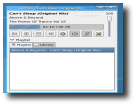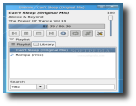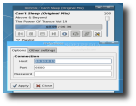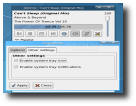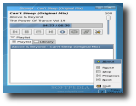Audio players for Linux have come a long way since graphical desktop environments were made available. Over the years, more and more audio players were released, while the old ones were constantly being updated. Now, it's pretty hard to choose from a very large number of players, each with its own features, advantages and disadvantages.
Gimmix, however, is not an ordinary audio player. It requires a lot more than running it and pressing the play button to listen to music. Gimmix is just a front-end to MPD (music player daemon), which will require to be installed, configured and started in order for Gimmix to run properly. MPD is basically a server which allows remote access for playing audio files, streams and managing playlists. What's really impressive about this design is that the client used for controlling the server doesn't need to run on the same machine MPD runs on. This enables you to play the music files on your home server from work, a friend's house or wherever, as long as you have Gimmix with you.
Gimmix is a quite new player, it was first released in October this year and in about a month, has reached a development level most players don't touch for another year. Installing Gimmix is a very simple process, just enter its directory, type make and make install. Unfortunately, installing its dependencies could cause severe head aches for most Linux beginners, probably forcing them to drop the whole process.
Gimmix requires Gtk+-2.10.x, libglade-2.6.0 or higher, libmpd-0.12.0 or higher, libnotify-0.4.x, libconfuse-2.5 and, of course, a working MPD. I'm running Fedora and unfortunately, couldn't find libmpd on any repositories, so I had to compile it from source. This was a pretty bad idea because the files needed for pkg-config were copied to a directory they shouldn't be in. So I had to manually copy libmpd.pc from /usr/local/lib/pkgconfig/ to /usr/lib/pkgconfig/. Next, I had to create a symlink from /usr/local/lib/libmpd.so.0 to /usr/lib/libmpd.so.0 just to get Gimmix running.
Now, in order to have Gimmix also playing some music, I needed MPD installed and running so I've started searching for it in the repositories, found available on Livna and installed it. By default, the music files will need to be manually added to /var/lib/mpd/music. To create the initial MPD database, I typed mpd --create-db in a terminal as root. Finally, I ran it with service mpd start.
It was now time to run Gimmix by typing gimmix in a terminal. Because it was its first time running on this machine, I was asked for the MPD server host, port and password. I haven't touched mpd.conf so, by default, the server runs on port 6600 with no password. As for the host, I've entered the IP address of the machine MPD was installed on. The main window was pretty small but had all the functions needed for playing audio and managing the playlist. The upper part of the window had printed "Gimmix", its version (0.2 was the last version) and underneath was the player's web address. In the middle was a progress bar and finally, the lower part of the window had the play buttons: previous, play (which turns into pause while playing), stop, next, file info, repeat all, shuffle and preferences. The last button would open the preferences window which has two tabs: Options and Other settings. The first tab contains the server related options which I was asked about the first time I've opened Gimmix: host, port and password, while the second tab had two check boxes, whether to enable system tray icon and system tray notifications. Also, there was a volume bar in the far right part of the main window.
Underneath the play buttons was the Playlist toggle button, which would show or hide it. The playlist is also divided into two tabs: Playlist and Library. The Playlist contains the list of the currently scheduled for playing, while the Library tab contains the list with all the available audio files (all the files in the /var/lib/mpd/music directory). File names from Library can be added to Playlist with a simple double click or selecting it and pressing enter, while removing them from Playlist require a right click on the file name and clicking Remove. The Library tab has an update function found in the right-click menu and also a quick search feature (similar to Winamp's Jump to File function) which allows you to quickly find files in a long list.
At the bottom of the playlist, there were three buttons: add, remove or clear items to/from playlist. The same functions could be reached if the playlist section was right-clicked. My playlist was empty so I clicked the Add button, which opened a new window containing the audio files I've added earlier to /var/lib/mpd/music. To add a file to the playlist, I simply had to double click it.
The Good
Gimmix has a simple, yet nice user interface which is very intuitive and easy to use. Because it's based on MPD, you can listen to your files from any computer, as long as you have Gimmix and its requirements installed. Moreover, it has a system tray icon which enables quick and easy access to the player's controls.
The Bad
Because it's based on MPD, it also has disadvantages, the biggest one being that you can't add files to playlist from the computer you currently use. Also, listening to music files from another machine requires that you have an external IP address as the port isn't firewalled. Also, if you plan on listening only to high quality audio files such as 320kbps mp3 files or, even worse, FLAC audio files, you will need a pretty large connection bandwidth on both server and current PC.
The Truth
Overall, Gimmix is a great audio player but only for listening to music on your home Linux PC. It's small, requires very low resources and even supports systray icon integration. Unfortunately, installing its dependencies could take some time and listening to high quality audio files will require you to have large connection bandwidth. However, if you just want to listen to music already on the current PC, I'd recommend you use a normal audio player because Gimmix (more exactly MPD) only allows you to play files from the MPD music directory.
Check out some screenshots below:
 14 DAY TRIAL //
14 DAY TRIAL // 